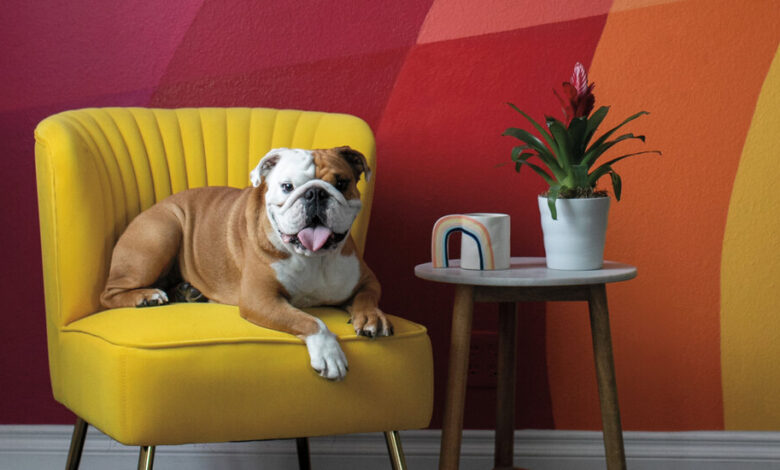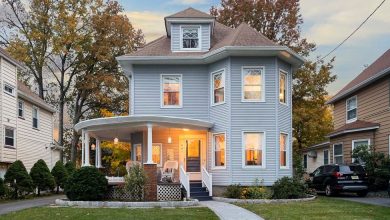Your Walls Don’t Have to Be Boring

[ad_1]
Facing a blank wall can be daunting. Often, we instinctively fall back on the most familiar option: “What color should I paint it?” Or maybe: “Should I add wallpaper?”
But there is a world of possibilities beyond basic paint and wallpaper that can make a dramatic change to a room: You could paint a blank wall with a mural, coat it in lime wash, install paneling or add decals.
“When you paint a wall with flat paint, you just see color,” said Genna Margolis, the founder of Shapeside, an interior design firm in Los Angeles.
With other wall treatments, you see something more: a graphic pattern, a texture, a sense of variation.
And while some showstopping wall finishes involve precious materials and laborious techniques that are better left to professionals, others are easy enough to pull off by yourself. Designers and manufacturers recently shared advice on do-it-yourself alternatives to ordinary paint and wallpaper.
Paint a Mural
The thought of painting a mural might be intimidating, conjuring visions of elaborate nature scenes filled with flowers, trees and animals that extend floor to ceiling and wall to wall. But not every mural needs a skilled artist’s touch. And it doesn’t have to be expansive.
“Sometimes, painting a full wall would be too much — it would completely overpower the space,” said Phoebe Cornog, a founder of Pandr Design Co., which has designed and painted murals in sports stadiums, shopping centers, offices and homes. “Doing a section of a wall can add a bit of color, but not completely take over.”
In “Wonder Walls,” a new book from Storey Publishing, Ms. Cornog and her partner, Roxy Prima, lay out step-by-step instructions for creating simple, compact murals, including one composed of five parallel lines in various colors; one made from an overlapping arch, circle and rectangle; and one centered on a large-scale triangle.
The key to these straight-lined designs is using painter’s tape to create crisp edges, Ms. Prima said. But she and Ms. Cornog also encourage trying freehand designs made from repeated elements — a wall of polka-dot paintbrush splotches, say, or an expanse of intersecting blobs.
“It shouldn’t be intimidating,” Ms. Prima said. “It can seem like a very permanent and large-scale thing, but if you mess up, you just wait for the paint to dry and then paint over it.”
For those who want to try something more intricate, like a landscape scene, Ms. Cornog and Ms. Prima said one piece of equipment is key: a projector. You can project a desired design onto the wall, trace it with pencil or chalk, and use those lines as a guide for the paint.
And remember: No matter what style of mural you choose, the result doesn’t have to be perfect.
“Always stand back to look at your work,” Ms. Cornog said, and don’t sweat the details. “People tend to get really sucked into the nitty-gritty, looking at the wall up close, and forget that no one’s actually going to be staring at your mural that closely.”
“Everyone wants plaster,” Ms. Margolis said, but it can be difficult to get the application right and is often best left to a professional, which can be costly. That’s why lime wash, sometimes called lime paint, has become so popular. “You get the same look without the price,” she said.
First prepare the wall by rolling on a special mineral-based primer, said Burju Garnier, a founder of San Francisco-based Color Atelier. Once it’s dry, apply the lime wash with a wide paintbrush.
“Typically, it’s applied in two coats,” Ms. Garnier said. “Our preferred method is applying it with a block brush, using really random, multidirectional strokes. When it dries, it gives you that soft color variation, with a matte, velvety finish that is aesthetically very pleasing.”
Off-whites and light colors tend to show just a little variation, she said, while darker colors can show a lot.
If you’re nervous about whether your brush strokes will create the look you want, try painting some sample boards before tackling the whole room, suggested Ms. Margolis, who has used lime wash from Portola in dining rooms, bedrooms and bathrooms.
For high-traffic areas, where you want the finish to be wipeable, or in wet areas like a kitchen or bathroom, Ms. Margolis and Ms. Garnier recommended applying a specialty sealer over the lime wash for protection.
Panel It
From simple wainscoting to full walls of intricately carved timber, wood paneling has been used to add decorative detail and protection to walls for centuries, long before drywall existed.
Today, the warm look of wood paneling remains popular, as people create feature walls with materials like bleached oak or weathered barn board. And there are products that make installation easier than ever.
Paneling from companies like Stikwood, Timberchic and Plank and Mill is made from real wood, but the boards are thinner than standard paneling, which makes them easier to cut and handle, and they come with a peel-and-stick backing, so no nailing is required.
Bobby Berk, the Los Angeles-based interior designer and television personality, has used Stikwood in his own home, as well as rooms featured on “Queer Eye.” “I just like the ease of use and the fact that it looks great,” he said. “You can dramatically change a space with a small budget and a small saw.”
In a guest room at his home, Mr. Berk used Stikwood to create a feature wall behind the bed. In other projects, he has used it on walls and ceilings in living rooms, bathrooms and kitchens — “just about everywhere,” he said, “except on the floor.”
The adhesive backing is usually strong enough to keep the planks in place, he said, but in extremely humid environments, he sometimes adds construction adhesive or a few nails for extra support.
The finished result, he said, “looks just as real as doing big, expensive planks.”
If you prefer something other than wood, consider self-adhesive panels made of cork, from a company like Muratto, or felt, from companies like FilzFelt or Felt Right.
Add Decals
Wallpaper isn’t the only way to add graphic appeal to a wall. Wall decals create a similar effect but are easier to apply, leave room for customization and are easy to remove if you get tired of them.
In recent years, numerous companies, including The Lovely Wall Co., Urbanwalls and WallPops, have expanded the range of available designs, from large-scale florals and doorway-size arches to subtle dots and lines that resemble brushstrokes.
Rebecca Simon, the founder of Maison Ellie, an interior design firm in Ottawa that focuses on children’s rooms, has created feature walls with decals that look like confetti, leaves and cactuses.
“You can make the wall appear wallpapered,” Ms. Simon said, if you apply the decals across the entire surface. But they are much easier to install, she added — just peel and stick them — and usually cost much less than wallpaper.
Decals can be just as appealing in rooms for grown-ups. “If you choose the right design, it can look sophisticated and trendy, just like traditional wallpaper in living rooms, bathrooms and dining rooms,” said Megan Close, the founder of The Lovely Wall Co. Decals are durable enough, she noted, to be used even in kitchens and laundry rooms.
And because you decide on the spacing between the decals as you stick them on the wall, the look can be as minimal or maximal as you desire.
“You don’t need a lot,” Ms. Close said, “to make a big impact.”
For weekly email updates on residential real estate news, sign up here. Follow us on Twitter: @nytrealestate.
[ad_2]
Source link






